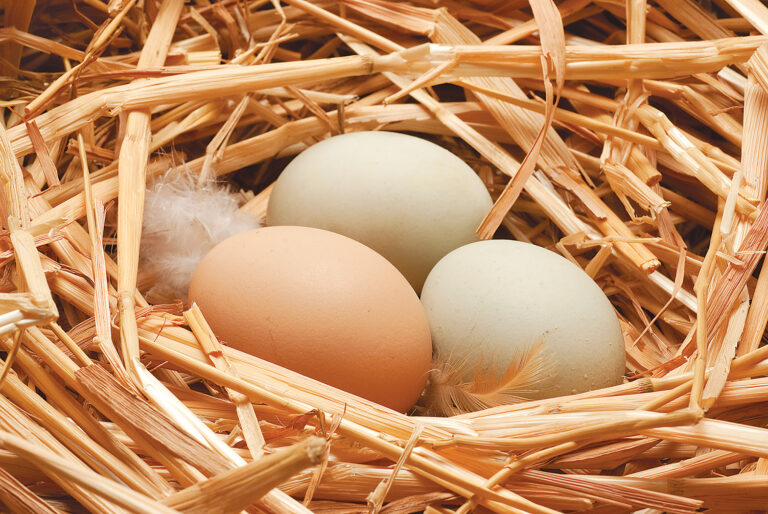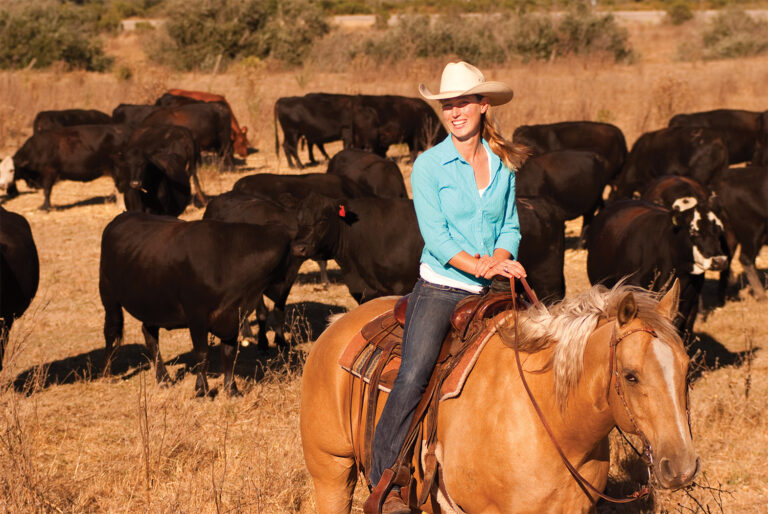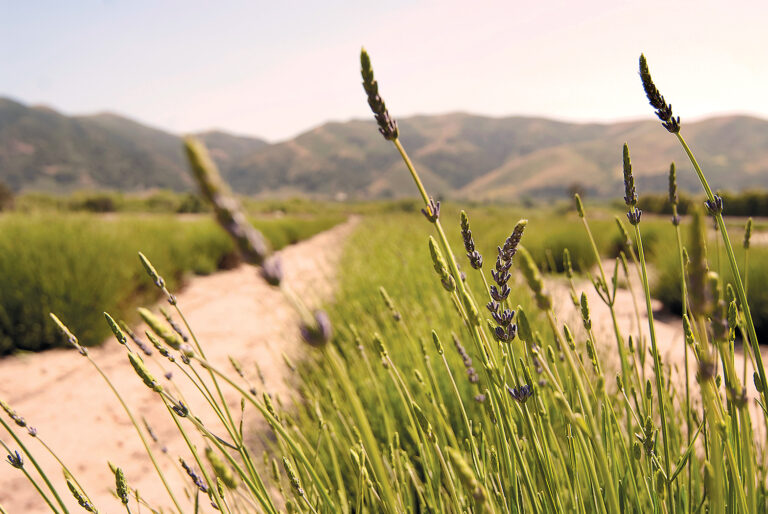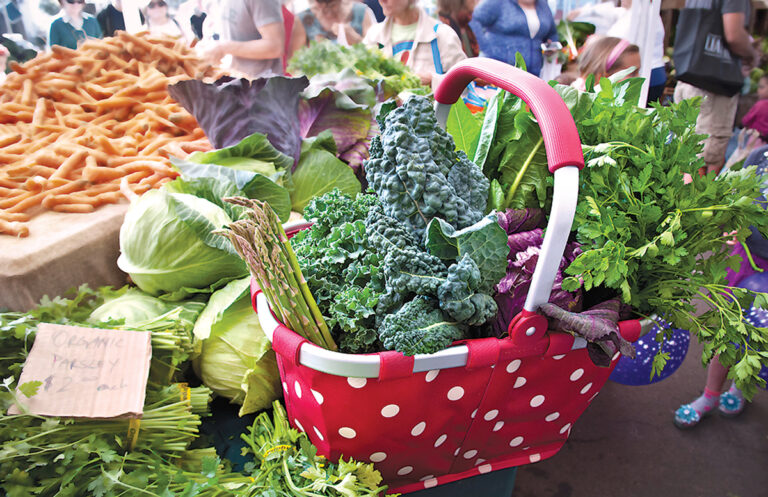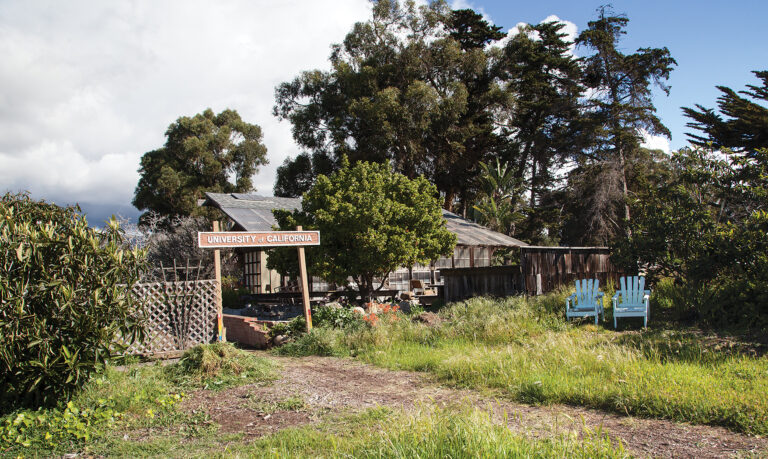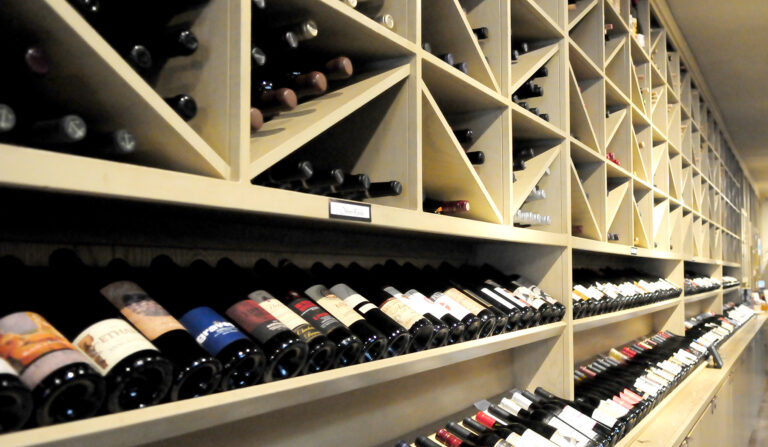Julia Child’s Return to Her California Roots
Santa Barbara Sojourn
Near the end of her long and storied career, Julia Child could have chosen to live anywhere in the world. The convivial TV celebrity and cookbook author had spent years abroad in cities from Paris to Oslo, and for decades split her time between homes in Cambridge, Mass., and Provence. But after her beloved husband, Paul, died, the then-89-year-old Julia pulled up stakes, sold her New England home (donating her entire kitchen to the Smithsonian Institution) and abruptly moved to Montecito in 2001. That’s where, until her death, she spent a few short years, which, along with previous Santa Barbara sojourns in the 1980s, became the stuff of local legend.
Ask around about Julia in longtime restaurant and farmers market circles and nearly everyone brightens up with a story to share—or else knows someone who has one. Even now, 15 years after her death, people attribute La Super-Rica taqueria’s lines out the door to Julia. But why did she choose Santa Barbara, and what was her life like here?
“I love Santa Barbara. I was born in Pasadena, but I’ve been going up to Santa Barbara all my life.” —Julia Child, 1995 Westways story
In the early 1900s, Santa Barbara was a chic destination for holidays and health retreats for upper-middle-class families from the East Coast and throughout Southern California. Julia’s parents, John McWilliams and Caro Weston, ran in the same social circles, and they courted each other in Hope Ranch in 1905, according to biographer Noël Riley Fitch (in Appetite for Life). Caro had thought Santa Barbara’s warm, dry climate would be good for her sister Dort’s health, and “Johnnie” took the sisters horseback riding in the hills.
After they married and had children, the McWilliamses spent family vacations in the area through the mid-1920s. (Julia’s younger brother John was even born in town during a summer holiday.) Among Julia’s earliest childhood memories was a train ride to visit her aunt Bessie, who lived in Santa Barbara, and her very first experience of seeing the ocean was at Miramar Beach.
For several summers, they stayed at Montecito Park, a circle of gray-shingled cottages around a green lawn and surrounded by bamboo groves, where the Biltmore Hotel was later built in 1927, and they met up with other Pasadena families and schoolmates.
For Sunday lunches, “we would go to the old Miramar Hotel,” Julia recalled in a 1995 Westways story. “They had a big circular dining room, and we always thought it was fascinating because there was sherbet in the middle of the meal.”
She learned to swim in the city swimming pool and spent time at the beach. For several years, Julia also attended Camp Asoleado, a girl’s camp on the Mesa, with her cousin, where she had fond memories of weekly pancake-eating contests.
“I am, as you know, a Californian, and still have that feeling in my bones…” —Julia Child in a 1981 letter to Louisette Bertholle
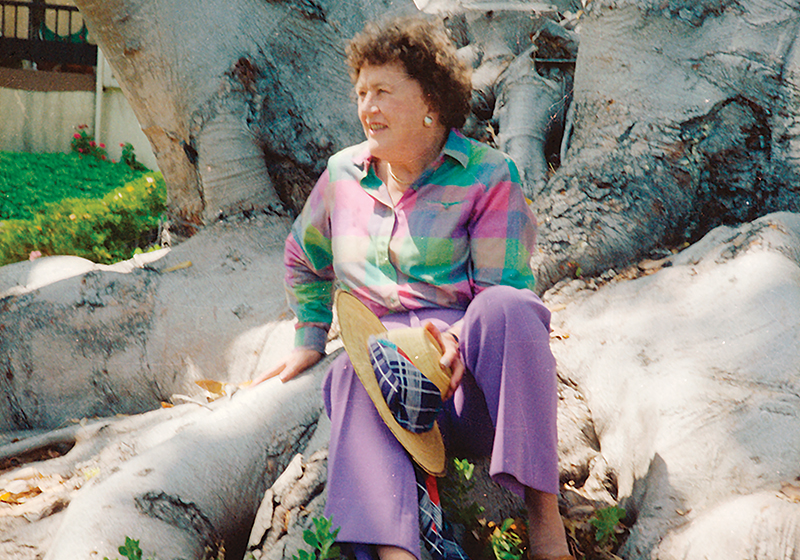
After heading back east to attend Smith College, Julia went abroad to do administrative work for the U.S. Office of Strategic Services during World War II, where she met her future husband, Paul Child. Later, she made her name teaching the American masses how to master the art of French cooking through the best-selling cookbook she co-authored and the decade-long WGBH TV series “The French Chef”—periods of her life well chronicled in numerous biographies and films.
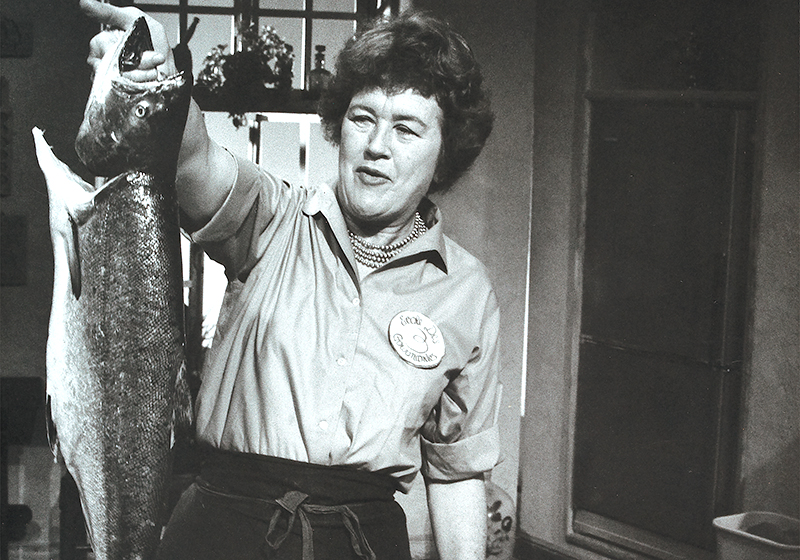
Harvard University, Schlesinger Library.
Even though they spent most of their adult lives entrenched in the East Coast and their adopted home of France, Julia and Paul periodically came back to California. While they were in the diplomatic service, the couple visited Santa Barbara on home leaves. Then in the early 1980s, when Julia was in her 70s and Paul in his 80s, the couple started spending winters in Montecito, where the weather better suited Paul following a stroke and it felt less crowded.
“The climate and the atmosphere [of Santa Barbara] recall the French Riviera between Marseille and Nice,” wrote Julia. “Very often, being there on the Riviera, where we used to have a little house, I’d… say, ‘Well, I’d just as soon be in Santa Barbara.’”
In 1981, they bought a condo in Montecito Shores, not far from where she’d vacationed as a child. The plan was to eventually retire there—but the prospects of that seemed far away for Julia, who was always on the go.
The couple was quickly embraced by the Santa Barbara community. Not only did Julia know families from Pasadena who lived in the area, but her own sociability and interest in culinary topics exposed them to locals in the burgeoning wine scene, as well as farmers and chefs.
Just before the Childs moved to Montecito, Richard (“Dick”) Graff, the owner of Chalone Vineyards in Monterey County, invited Richard and Thekla Sanford to meet them. The Sanfords were the proprietors of Sanford & Benedict winery at the time, making the first Pinot Noir in Santa Barbara County in the Sta. Rita Hills.
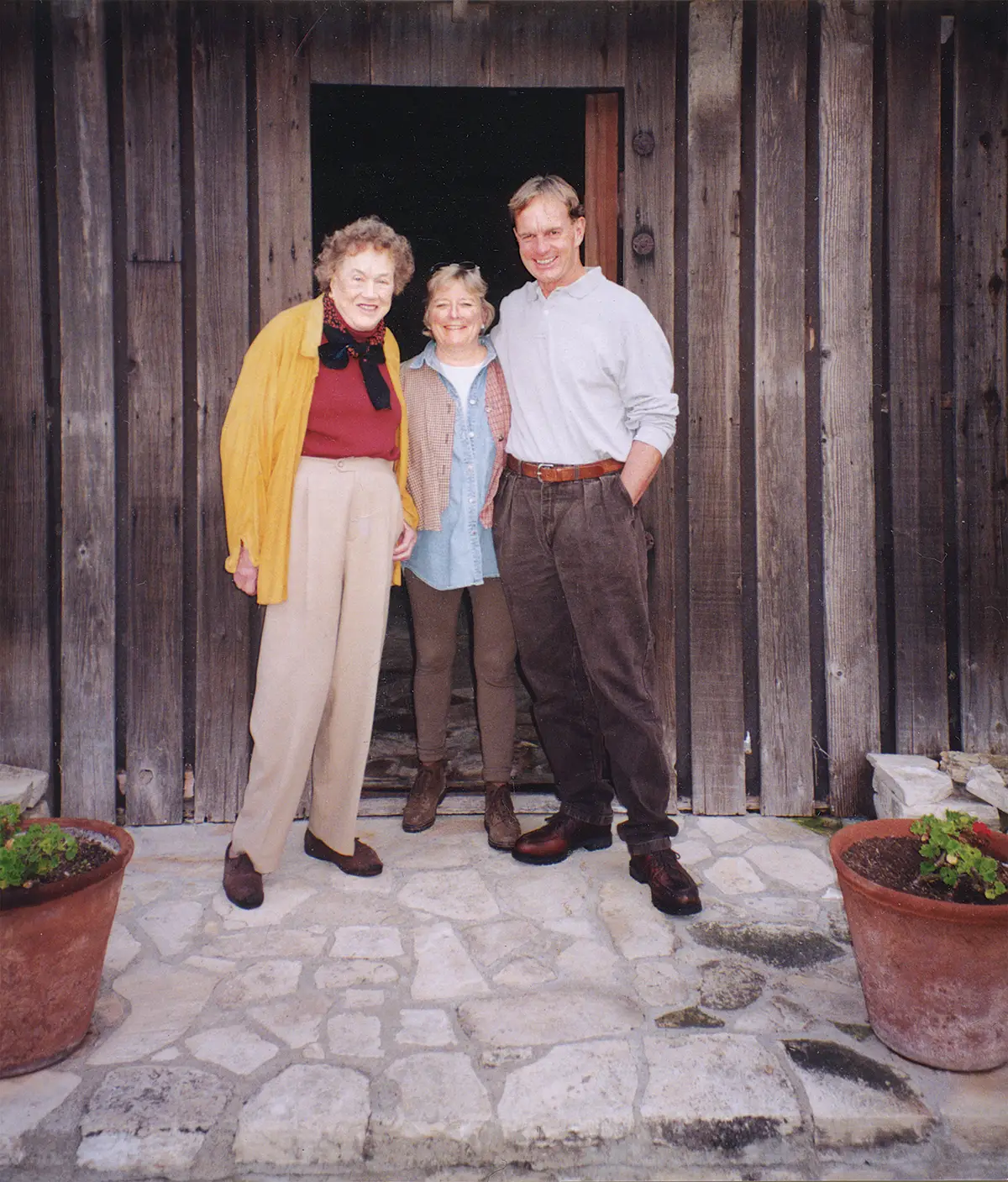
Richard Sanford reminisced: “[Dick] called me up and said, ‘Julia and Paul are coming out to California and they’re Francophiles. They’re really focused on French wine, and I need your help in showing them what California wine is all about. We have to change her perception.’”
They decided to have a picnic where they would pour their wine. When he told her who was coming for lunch, “Thekla almost collapsed,” Richard recalled with a chuckle.
But Julia and Paul were completely taken by their Pinot Noirs.
“That began our lifelong friendship with Julia,” said Richard. “She just fell in love with the wines, and she liked to be involved with people who were doing things, young people who were inspired.”
“Montecito is indeed a bit of heaven.” —Julia Child in a letter to M.F.K. Fisher
While spending winters in Montecito, Julia continued to work, writing monthly stories for McCall’s and then Parade magazine, for which she researched and tested recipes, and prepped for cooking classes that she taught around the country.
During the first several months of 1983, a mansion in Hope Ranch became the home base for a new TV series, “Dinner at Julia’s,” produced by WGBH, which aired on PBS. Thirteen 30-minute episodes featured Julia behind the scenes sourcing regional American foods throughout the country, cooking with a celebrated guest chef, and hosting a dinner party at the house.
One of the segments included an expedition to collect chanterelles at a secret spot on the South Coast, where a reporter from Time recalled Julia “slogging through viscous mud that bogged down her party’s four-wheel-drive Bronco,” all while wearing a pith helmet and sporting a walking stick. Local chef Michael Hutchings helped source the mushrooms for her.
Famed chefs from around the U.S. came to film segments, including Wolfgang Puck and Bradley Ogden (in his pre–Root 246 days). Students from Santa Barbara City College’s hotel and restaurant school assisted with food preparation, and among other local delicacies showcased were Santa Barbara spot prawns and Santa Barbara bouillabaisse, as well as wines from Sanford & Benedict and Firestone Vineyard.
At gatherings in Santa Barbara in the early ’80s, Julia started having conversations with influential colleagues, such as winemakers Robert Mondavi, Dick Graff and Richard Sanford, and chefs like Alice Waters and Jeremiah Tower, about the need for culinary education in America—and the American Institute of Wine & Food was born. One of the ideas was to bring together culinary professionals, laypeople and academics, and UC Santa Barbara’s then-chancellor Robert Huttenback floated the idea of providing a facility on university land at Devereux. While the building for the institute didn’t end up happening (a later incarnation resulted in Copia in Napa), some of the early fundraisers and a conference held on the South Coast helped launch the organization.
Eric Spivey, then an undergraduate student in economics and environmental studies at UCSB, who wrote a paper on the economics of small wineries, got to know Julia better through the AIWF. He would later become a close friend of Julia’s, as well as chairman of the Santa Barbara–based Julia Child Foundation for Gastronomy and the Culinary Arts, which safeguards her legacy.
“Just this morning I looked out on another sparkling day, and I said to my breakfast group, ‘Why live anywhere else?’” —Julia Child, 2002 National Geographic Traveler story on Santa Barbara
Julia permanently moved to Casa Dorinda in Montecito in November 2001. Her old Pasadena schoolmates were part of the draw for her. “A good portion of that group of friends ended up at Casa Dorinda,” said Alex Prud’homme, nephew of Paul Child and co-author of My Life in France, Julia’s memoir. By coming to Santa Barbara, “she ended her life with some of the people she began her life with.”
(That final chapter almost didn’t happen. Julia and her assistant Stephanie Hersh originally were booked to fly out on the 9/11 American Airlines flight from Boston to Los Angeles that was hijacked and crashed into the World Trade Center, according to biographer Bob Spitz in Dearie. A last-minute schedule change saved them from a tragic fate.)
Julia’s Casa Dorinda friends were a group of feisty octogenarians with whom she had breakfast nearly every morning at a corner table in the dining room. Ever mischievous, she frequently snuck slices of bacon from breakfast back to her apartment in her purse, where she’d also stowed away a stray cat she’d adopted named Minou—a no-no at the time.
She entertained a steady stream of visitors at the retirement home. Although cooking became less of a preoccupation when she downsized, she had her apartment’s kitchen specially outfitted with a small pegboard wall for hanging whisks, colanders, measuring cups and more, like the one her husband famously made for their kitchen in Cambridge, now permanently on display in the Smithsonian.
But Julia also loved getting out and about. She visited the Santa Barbara farmers market most Saturday mornings with her late friend Lorenzo (“Dal”) Dall’Armi, a former Santa Barbara County superintendent of schools. Julia loved fresh fruits and vegetables, cut flowers, whatever looked good at the market that day and ingredients for recipes she was writing about.
Even when she had to be wheeled around in a wheelchair due to hip problems, “she would want to talk to every single vendor,” said Alex Prud’homme, who spent time with Julia in Santa Barbara when they were working on her memoir. “She’d say, ‘Oh, I’m learning to cure my own olives.’ ‘These strawberries are so delicious; they remind me of the ones we got in France.’ She was very chatty and liked to talk with everybody. It was a weekend ritual.”
Rose Story Farm in Carpinteria, owned by Bill Hahn and Danielle Dall’Armi, the daughter of her farmers market pal, was another favorite place of Julia’s. Sometimes she’d drive in a golf cart around the 15-acre rose farm four or five times a week. She even picked out a specimen that they formally named the Julia Child Rose following her death—a pale yellow, hearty hybrid that these days can be found growing at the A.C. Postel Memorial Garden across from Old Mission Santa Barbara, at Ganna Walska Lotusland and at Casa Dorinda.
Eating out was also high on her list of priorities: She’d typically take breakfast at the Casa and then have lunch and dinner out. “It could be ranging from the Wine Cask at New Year’s Eve to Citronelle when Michel-Richard was there, to Paradise Café to Lucky’s, to Costco hot dogs. She loved her Costco hot dogs! She loved McConnell’s ice cream,” said Eric Spivey, a regular meal companion. “At that point in her life, she really transitioned from being just French-focused in food to a much broader set of tastes.”
The late Downey’s, Olio e Limone, Bouchon, Belmond El Encanto, San Ysidro Ranch, the Santa Barbara Shellfish Co. on Stearns Wharf, and even In-N-Out Burger were among some of her other local haunts. Lucky’s, which she called a “jolly place,” was one of her favorites, with its ribeye steaks.
Recalled Thekla Sanford, she loved “those lovely, tiny onion rings at Lucky’s and the sole meunière—it reminded her of the sole meunière she’d had in France. That was her epiphany—along with the roast chicken—that got her into cooking.”
“The thing that was so fascinating to me while going out with her was that she was such a celebrity but didn’t act like it,” said Spivey. “You’d walk into a restaurant and people recognized her. But she worked her way every time into the back of the restaurant, into the kitchen, and would sit there and talk with the chef, but also the sous chefs, the prep people, the dishwashers, the waiters, everyone. She wanted to hear their stories.”
And what about La Super-Rica Taqueria—a place closely associated with Julia Child?
Some friends dispute that it was her favorite restaurant. “How that got so out of whack, I don’t know,” Thekla Sanford said with a chuckle.
It all began in 1985, when Julia filmed four short segments set in Santa Barbara for ABC TV’s “Good Morning America.” Not many people remember the segment where she clambered onto an oil rig in the Santa Barbara Channel and interviewed the galley cook about his style of cuisine. But her episode on La Super-Rica, as an example of Santa Barbara’s Mexican cuisine—and Julia’s later references to it in interviews for outlets like Bon Appétit—cemented the eatery’s place in local food lore. Julia hadn’t even been much of a Mexican food fan before but praised La Super-Rica for its “authentic Mexican home cooking.”
Julia never lost her insatiable curiosity and desire to explore, even into her late 80s and 90s. “We’d be working away [on the manuscript for My Life in France] and she’d say, ‘Let’s get something to eat,'” recalled Alex Prud’homme. They’d take a break for a meal, which would be followed by, “Let’s go up this road.” And soon they’d be off on an adventure. If they came across a private property sign, invariably Julia would egg him on. “Don’t worry about it. I bet there’s a lovely view of the ocean. We’ll just say we’re looking for Mr. McGillicuddy,” he recalled her saying. “She was so mischievous. It was great fun.”
Thekla Sanford remembers a New Year’s Eve in the late ’90s when there was a big windstorm and they ventured out with Julia to a black-tie party in Montecito. “We had a Toyota Land Cruiser, and we start this journey, which is like being on a safari in Africa. Just trees everywhere. We were going from the Biltmore to just above Lotusland on Cold Spring Road; this Toyota is just crawling over them and [Julia] goes, ‘This is really fun!'”
Just two days before her 92nd birthday, Julia Child passed away in her sleep, with her cat Minou by her side. Her friends had planned a big birthday celebration for her and more than a hundred well-wishers were already heading to Santa Barbara from far and wide. “Almost all those friends still came out,” recalled Eric Spivey, who shared the same birthday as Julia. “It ended up being a memorial at my home, a festive memorial. Reflective, fun, but sad at the same time, that gave us all a chance to talk about Julia.”
Her last meal, quintessentially Julia, was French onion soup.

